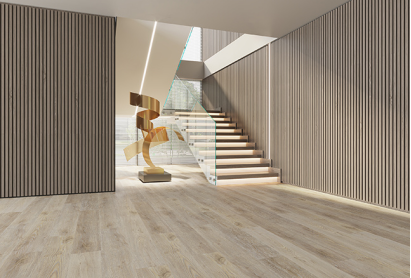

If you're planning to install vinyl plank flooring, one important factor to consider is the direction of the planks. The direction you choose can affect the overall look and feel of the room. In this article, we'll explore some of the key factors to consider when deciding on the direction to lay vinyl plank flooring. We'll discuss different layout options, such as laying the planks parallel or perpendicular to the longest wall, and explore how to choose the best option for your space based on factors like lighting, room size, and other factors. So you'll have a better understanding of how to choose the best direction to lay vinyl plank flooring for your home renovation project.
1. Horizontal: Installing your flooring boards horizontally is a great option for narrow rooms. Laying the boards width-wise will make the surface appear wider, avoiding a boxed-in effect. To enhance this effect, avoid using dark colors on either the floor or walls as they can make a narrow room look even narrower.
2. Vertical: If you're working with a short room, laying your flooring vertically can add a sense of depth and make the room appear longer. Combining a light-colored floor with darker walls can further enhance this effect.
3. Diagonal: To add visual interest to a small room with minimal extra effort or cost, consider diagonal flooring. This type of installation can be done at a 45-degree angle or even as little as 10 degrees. Diagonal flooring can make a room look larger and create a unifying effect by tying the wall visually to one in another room.
1. Consider Adjoining Rooms
When choosing the direction to lay your vinyl flooring, it's important to consider how it will look in transitions to adjoining areas such as rooms, hallways, and stairs. Here are some things to keep in mind:
l Continuity: If you have similar flooring in other spaces, you may want to install the vinyl plank flooring in the room so that it follows the same direction.
l Matching: To create a sense of continuity between rooms, choose a vinyl plank flooring finish that resembles your existing flooring. This can help create a seamless transition from one space to another.
l Contrast: Alternatively, you can use the transition between rooms as a feature and create a distinct differentiation between the spaces. Changing the flow of the vinyl plank flooring can create an interesting contrast and draw attention to the transition point.
2. Think About The Light
Take into account the main source of light in your room. If you have a large window or glass door, the light will stream through and create shadows in a particular direction. Laying your vinyl planks towards the door or window will align the seams with the direction of the sun's rays, creating a visually appealing effect.
3. STAIRS AND ROOM FEATURES
Structural elements such as stairs, chimneys, cabinets, closets, and doorways can impact the overall design of the room. Consider designing around these features to ensure a quality design. Keeping the direction of the vinyl perpendicular to stairsteps and other features can help bring the room together in a cohesive design and make fitting and cuts easier to achieve. Alternatively, pointing the direction of the vinyl planks toward room features like a fireplace can draw attention to it and make it a focal point. If you want to showcase your room features, consider laying the planks to flow directly towards them.
4. What About Focal Points
Consider your room's focal point, such as a fireplace or a striking piece of furniture like a desk. You can use this to your advantage when selecting the direction of your flooring. By aligning the planks with the focal point, you can further emphasize it. This is because the lines between each row will draw attention towards it, creating a more impactful and cohesive look.
5. Consider Other Patterns
If you’re not sure about a vertical or horizontal layout, you can consider other patterns. The chevron pattern is a popular choice that can look stunning with vinyl plank flooring. This pattern can work well with both traditional and contemporary interiors, making it a versatile option to consider.